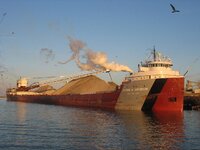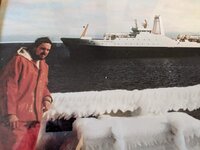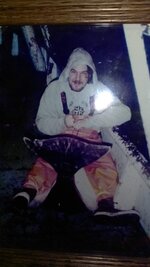If I get down to the dock tomorrow ilI' take some pictures of my brother in-law boat they had to replace the front windows a few years ago they were way out tuna fishing and the waves blew out the front windows .We took the Victoria Clipper a few days before Christmas one year and they put boards over some of the lower deck windows. Man you want to talk about waves in the Strait of Juan de Fuca. They rightly call it the "Strait of Wanna Puka". The only reason I didn't since I took a Dramamine before the ferry left the port in Seattle. I rode the ferry numerous times with family over the years but never during the holidays so I thought "Just in case" situation.
Navigation
Install the NWFA app
How to install the app on iOS
Follow along with the video below to see how to install our site as a web app on your home screen.
Note: This feature may not be available in some browsers.
More Options
You are using an outdated browser
The browser you are using is likely incompatible with our website. We recommend upgrading your current browser or installing an alternative.
JavaScript is disabled
Our website requires JavaScript to function properly. For a better experience, please enable JavaScript in your browser settings before proceeding.
-
Join the #1 community for gun owners of the Northwest
We believe the 2nd Amendment is best defended through grass-roots organization, education, and advocacy centered around individual gun owners. It is our mission to encourage, organize, and support these efforts throughout Oregon, Washington, Idaho, Montana, and Wyoming.Free Membership Benefits
- Fewer banner ads
- Buy, sell, and trade in our classified section
- Discuss firearms and all aspects of firearm ownership
- Join others in organizing against anti-gun legislation
- Find nearby gun shops, ranges, training, and other resources
- Discover free outdoor shooting areas
- Stay up to date on firearm-related events
- Share photos and video with other members
- ...and much more!
No I been wrong before I'll admit it.
Lol once or twice a year I get something wrong.
So there you go . I'm not right all the time
Once I thought I was wrong... But I was mistaken.
- Messages
- 4,160
- Reactions
- 19,329
but that's the ocean. Where you get tides and huge swells
It's not just swells or ocean tides... a 5 ft WIND wave on open, deep, water can become much stronger as the bottom comes into play. The floor of a lake , river, or ocean slows the wave more and more, causing it to "pile up"(a function of wave spacing to water depth)
Even a small body of water can be affected by high winds to the point that water on the windward side can cause flooding as the leeward side looses depth.
Obviously the bigger the water body the more dramatic the effect can be, but that is why these duck-tour companies convince themselves that for the most part that serious safety is a non-issue.
The "it's just a lake, what could happen?" attitude goes to decisions about training/intensity of the crew, selection of the vessel and how it's outfitted for weather emergencies and passenger safety. The company didn't think a loaded vessel on a lake could capsize due to weather and equipped it as such.
17 People died because it was "just a Lake".
Gold Supporter
Silver Supporter
Bronze Supporter
- Messages
- 4,261
- Reactions
- 5,937
How bout this the great lakes.
They have huge water and storms and swells
Great lakes ships that cross the View attachment 481131
Reminds of the SS Edmonds Fitzgerald which sank.
Same kind of boat almost .Reminds of the SS Edmonds Fitzgerald which sank.
Carrying Orr
Okay so looked around the internet and found some pictures of three of the big boats I worked on .
Lol they all are gone now except the SAGA SEA.
is in ARGENTINA last I heard.
I started on the CLAYMORE SEA .then I was on the HEATHER SEA .I worked the Heather sea the most .and I did a few trips on the SAGA SEA. These are all big factory trawlers.last picture is a net 100 tons of fish lol.and one is a painting done by a guy named DON KNOTS he paints pics of fishig boats



Lol they all are gone now except the SAGA SEA.
is in ARGENTINA last I heard.
I started on the CLAYMORE SEA .then I was on the HEATHER SEA .I worked the Heather sea the most .and I did a few trips on the SAGA SEA. These are all big factory trawlers.last picture is a net 100 tons of fish lol.and one is a painting done by a guy named DON KNOTS he paints pics of fishig boats
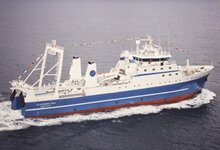

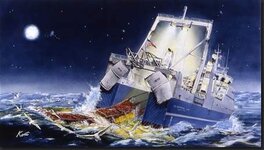
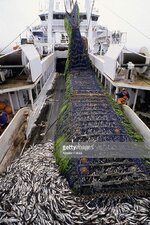
- Messages
- 11,081
- Reactions
- 50,429
Probably would not have helped since the boat was enclosed and there is no open deck to get people on.
Well with a little common sense and looking at the situation I would like to think that I would have had enough grit in me to pick my kids up and throw them over board saving there lives.
Bronze Supporter
- Messages
- 3,520
- Reactions
- 7,481
These things tend to happen fast and it sounds like it was indeed shipping water before it rolled and sank. I would guess they will find failed or inadequate bilge pumps that could not keep up with the ingress of water. It is certainly time to analyze whether these craft with the modifications that have been made,are suitable to be carrying paying customers. Buses and planes have emergency exits and are clearly marked. On a plane you get the spiel about the exits and what to do in emegencies. Life jackets are a big factor in most drowning accidents however in a covered space filling with water they can actually hamper egress. I think the canopy and window mods on these craft should come into serious question. I wonder if there is any other path to exit other than they way the people boarded. I am hoping some good comes from this tragedy.
14 people have died. Ad that to the other deaths from the other old Duck on the freeway going out of control. Looks like massacre numbers to me. Maybe we should think of bagging the practice of loading a bunch of civilians on these old slugs for a land/water tour?
In my short 30 year boating experience I learned there is no substitute for horse power/thrust. The boat I have now isn't really big, 17.5', but I upgraded the motor from the package deal when when I bought it so it jumps up on plane.
In my short 30 year boating experience I learned there is no substitute for horse power/thrust. The boat I have now isn't really big, 17.5', but I upgraded the motor from the package deal when when I bought it so it jumps up on plane.
- Messages
- 14,902
- Reactions
- 27,422
Or as the Engineers say, 'Power and thrust overcomes design inefficiencies'there is no substitute for horse power/thrust.
Passenger and commercial vessels pass rigorous tests before certification including stability. They are tilted to insure they can recover from an extreme breaching wave (called an incline test) and various other attitudes designed to insure stability. I prefer a boat with more beam but these have passed all the required tests for passenger operation. All of these insodents were operator error.........plain and simple. The numbers of people that have ridden on them as opposed to the casualties is a huge ratio. They are so popular that companies started building them from scratch 20 years ago. I don't like being with a lot of people in close quarters (anywhere) so you wouldn't find me on one but when we used them for salvage work, they were quite stable. These are 96" wide and about 31 feet long, as I said earlier, a bit of a canoe but highway vehicles are restricted to 102" wide without overwidth permits. The LARCS are wider, up to 24 feet for my LARC LX. So there are operational limitations on the DUKW, we had to be careful lifting with a crane on the beam but all mechanical systems have limitations that require a trained operator. (How many of us stabbed ourselves with our first pocket knife?) These can feel a little like a cork when operated light, the passenger seats are a little high that could make them a little top heavy compared to carrying heavy freight lower in the hull but those tests have been done and the boats passed. They might be more stable with some ballast low in the hull like any sail boat or typical fishing boats that are best operated with a heavy load. Even huge oil tankers ballast down when traveling unloaded to maintain stability.........but I keep coming back to the fact that they passed the tests that have proven seaworthiness for a hundred years. If the design had a "wet" deck below the passenger seating with appropriate ballast in it would be uneffected by flooding and have superior reserve buoyancy. My large landing craft were built like that but the smaller (56 foot) ones were not they would flood and sink if poorly handled. We had one parked at a Navy pier over night, the dock personnel were monitoring the lines and allowed the bow door to get up under the pier, when the tide came in it shoved the bow down and she flooded. When we went to get her early the next morning, there she was on the bottom still tied up in 40 feet of water. The Navy was very apologetic and picked her up with a crane for us. 10 days and new electronics later she was back in operation. Stuff just happens. Airplanes crash, trucks roll over and people die......it will never change as tragic as it is at the time.
That Bearing sea is a perfect example of how shallow water increases wave action that BBASS was talking about. It is one of the roughest seas on the planet and also one of the shallowest. We have worked there and my daughter was on a 378 foot cutter there for 2 years.........tough duty.When I worked on them they where all owned by by EMERALD RESORCRES BASED OUT OF SEATTLE.they later where sold off to different places .I know the Heather sea and the CLAYMORE SEA are no more scraped out they were the oldest ones
Gold Supporter
- Messages
- 13,081
- Reactions
- 46,583
With PFD's on of course. Would rather see them tread water than go down with the ship, no doubt about that.Well with a little common sense and looking at the situation I would like to think that I would have had enough grit in me to pick my kids up and throw them over board saving there lives.
This is such a sad story. So many lives lost unnecessarily. I really have to wonder if they are required to check the weather before they go out? Back when I was getting my pilot's license, we were required to check with the weather service to make sure there weren't any thunderstorms nearby or other unexpected weather events. Embedded thunderstorms were the most dangerous for our little planes - you couldn't see them, it could just look like a normal cloudy day, then you get hit, hard. I had it happen to me with 3 passengers in the plane not long after I got my license. In my case, the weather service hadn't given a warning for them - and this was back in the late 80's before easy access to weather radar on the internet. I was very worried we were in trouble so I did what I was trained to do if in that kind of trouble, turned and immediate 180 and went in a straight line as fast as I could to the nearest airport and landed just as the storm really unloaded on us. In my case, my training probably saved us because I knew, without having to think about it, exactly what to do. Sounds like folks that operate craft like this could use some real training, not only in what to do in an emergency like this, but in checking forecasts, radar, etc. for storms like these before they ever go out.
My worst experience in a boat in bad weather was on a cruise ship to Alaska about 6 years ago. On the 2-day trip up from Seattle, our 'at sea' time was really rough. There was a storm to the NW that caused us to hit some really big waves. And our cabin was quite far forward on the ship. I remember being in bed and feeling like we were weightless as we'd go up a wave, then come crashing back down. My poor wife was so seasick she didn't get out of bed those 2 days. My father, who was in the Navy in Vietnam, had been through a couple of typhoons, so to him, this wasn't a big deal. He just told us to get as close to the middle of the ship as possible to keep the movement around the center axis minimal. I was one of only 3 in our group that didn't get seasick. As I walked around the ship, holding the walls at times as things were rolling so badly, it was eerie how quiet the ship was - even 1/2 the crew was down sick. It was like a ghost town. I got video of the water sloshing completely out of the swimming pools, unfortunately, that memory card failed, and I lost that cool video . Anyway, I wasn't too worried as my father assured us these ships could take far worse than what we were experiencing, but to a land lubber, it was quite the experience. It was helpful to know that things would be fine, but I did make sure to keep our life jackets out and at hand and familiarized myself thoroughly with the various routes to an exit, if it were needed.
. Anyway, I wasn't too worried as my father assured us these ships could take far worse than what we were experiencing, but to a land lubber, it was quite the experience. It was helpful to know that things would be fine, but I did make sure to keep our life jackets out and at hand and familiarized myself thoroughly with the various routes to an exit, if it were needed.
On a different cruise, we were tendered to shore from the ship because the ship was too big to dock. The tender was one of the covered motorized life boats. And the water was quite rough that day. My wife, brother and SIL were on that tender - my wife and brother did not do well, both got quite sick. The hard part in the life boat was no outside visual reference to maintain the horizon, and we were really rocking and rolling, so much so we were holding onto the seats to stay in them. My wife and brother both said they would never ever tender to shore again.
Then once in Hawaii, we got on a large catamaran for a little cruise out around Honolulu. It started out nice, weather was great. As we got further out to sea, it got choppy, really choppy, without warning. The captain told anyone that gets seasick to get to the stern and keep their eyes on the horizon. Those that did that, seemed to do fine, others were puking all over the place. The captain finally turned us back it was so bad - said he'd never seen it that bad before. Apparently some storm hundreds of miles away, created those huge waves. Again, I wasn't too concerned that the boat would be okay, but again, I had my eyes on those life vests and kept an eye on the crew to make sure they looked like they were still calm and in control. In this case, the crew seemed to know how to handle things and made the right call to get us back in when things got too rough.
You put a lot of trust and faith in people that operate boats, planes, etc. Sad when folks that run these operations choose to use folks with little training, give them little pay, then play games with the lives of their passengers. As others have said above, there is a lot of complacency people have built into them now. You really do have to think for yourselves, be observant, make a plan. Don't trust crews or technology to give you 100% assurance of safety. Be alert, vigilant, ready to act, as much as you are able, should something go badly.
My worst experience in a boat in bad weather was on a cruise ship to Alaska about 6 years ago. On the 2-day trip up from Seattle, our 'at sea' time was really rough. There was a storm to the NW that caused us to hit some really big waves. And our cabin was quite far forward on the ship. I remember being in bed and feeling like we were weightless as we'd go up a wave, then come crashing back down. My poor wife was so seasick she didn't get out of bed those 2 days. My father, who was in the Navy in Vietnam, had been through a couple of typhoons, so to him, this wasn't a big deal. He just told us to get as close to the middle of the ship as possible to keep the movement around the center axis minimal. I was one of only 3 in our group that didn't get seasick. As I walked around the ship, holding the walls at times as things were rolling so badly, it was eerie how quiet the ship was - even 1/2 the crew was down sick. It was like a ghost town. I got video of the water sloshing completely out of the swimming pools, unfortunately, that memory card failed, and I lost that cool video
On a different cruise, we were tendered to shore from the ship because the ship was too big to dock. The tender was one of the covered motorized life boats. And the water was quite rough that day. My wife, brother and SIL were on that tender - my wife and brother did not do well, both got quite sick. The hard part in the life boat was no outside visual reference to maintain the horizon, and we were really rocking and rolling, so much so we were holding onto the seats to stay in them. My wife and brother both said they would never ever tender to shore again.
Then once in Hawaii, we got on a large catamaran for a little cruise out around Honolulu. It started out nice, weather was great. As we got further out to sea, it got choppy, really choppy, without warning. The captain told anyone that gets seasick to get to the stern and keep their eyes on the horizon. Those that did that, seemed to do fine, others were puking all over the place. The captain finally turned us back it was so bad - said he'd never seen it that bad before. Apparently some storm hundreds of miles away, created those huge waves. Again, I wasn't too concerned that the boat would be okay, but again, I had my eyes on those life vests and kept an eye on the crew to make sure they looked like they were still calm and in control. In this case, the crew seemed to know how to handle things and made the right call to get us back in when things got too rough.
You put a lot of trust and faith in people that operate boats, planes, etc. Sad when folks that run these operations choose to use folks with little training, give them little pay, then play games with the lives of their passengers. As others have said above, there is a lot of complacency people have built into them now. You really do have to think for yourselves, be observant, make a plan. Don't trust crews or technology to give you 100% assurance of safety. Be alert, vigilant, ready to act, as much as you are able, should something go badly.
Well with a little common sense and looking at the situation I would like to think that I would have had enough grit in me to pick my kids up and throw them over board saving there lives.
Yes, but how you get out? Since it is enclosed on the sides, you try to get to a door, kick out a window, start a panic? Maybe there is enough alarm in a person to do something, to take SOME kind of action, maybe not. Besides grit, a person has to recognize the situation and the need to act. Not criticizing.
Share This Discussion
Similar threads
- Replies
- 8
- Views
- 791
Upcoming Events
New Classified Ads
-
Frankford Arsenal Quick-N- EZ Case Tumbler Kit
- Started by misterarman
- Replies: 0
-
Aero Precision AR15 10.3 ATLAS R-One MLOK Handgaurd - Black
- Started by CoolBreeze808
- Replies: 0
-
Misc. Parts, scorpion barrel, 1911 grips, 10/22 parts
- Started by Wookie1
- Replies: 0
-
Aero Precision 10.5 Barrel/Gas Block Assembly
- Started by CoolBreeze808
- Replies: 0
-
-
-
-
-
-
Support Our Community
If our Supporting Vendors don't have what you're looking for, use these links before making a purchase and we will receive a small percentage of the sale






